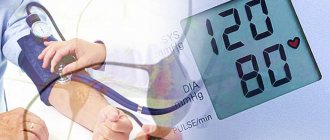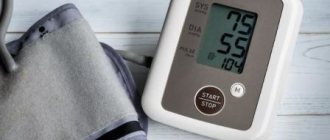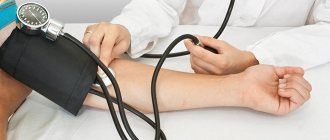Measuring blood pressure correctly is not as easy as some people think. Although today medical equipment stores and pharmacies sell various automatic blood pressure monitors, which can be used even by people without special education. But you still need to know how to correctly measure pressure with an automatic tonometer. If you do not follow the instructions for using the device, you may take incorrect measurements. And this can lead to errors that lead to incorrect diagnosis and treatment. You can control the course of hypertension based on blood pressure measurements throughout the day. For those suffering from hypertension, the device is simply irreplaceable during exacerbations. They have to take their blood pressure every hour.
Preliminary preparation for measurement
An hour or two before the blood pressure measurement procedure, there is no need to be nervous; it is also unacceptable to drink alcoholic beverages, coffee or tea, or energy drinks that contain caffeine. You do not need to eat food at least a third of an hour before measuring blood pressure. It is better to postpone smoking about half an hour before the procedure.
A quarter of an hour before determining the pulse and measuring blood pressure, it is recommended to sit down and be at rest, and five minutes inhale and exhale deeply 5-6 times. You should not measure blood pressure immediately after a stressful situation, at the measurement stage, in order to avoid errors. If the patient is upset or tired, the measurement should be taken only after he has calmed down.
If you need to go to the toilet, it is recommended to do this before taking measurements, because a full bladder increases blood pressure.
Blood pressure is determined where its values were higher during the first measurements. This is established after several measurements on both hands. The rules for measuring blood pressure with any pressure gauge are almost the same.
Semi-automatic devices
A semi-automatic blood pressure meter is a simplified equipment that allows you to measure the pressure of any person, regardless of education and mental development. Semi-automatic devices are sold in pharmacies at a reasonable price. To use this device you will need:
- Put on the measurement cuff, slightly above the elbow (closer to the shoulder), and secure it.
- Then press the button on the equipment.
- Inflate the air pressure cuff manually using a bulb.
As a result, measuring a person’s blood pressure becomes much easier, because a semi-automatic blood pressure meter deflates the cuff itself and shows ready-made results.
The downside to this blood pressure monitor is that it requires batteries or an electrical connection (depending on the manufacturer and model of blood pressure monitor you choose). Batteries require ongoing financial costs, but otherwise the device will not function, then such intravascular voltage control becomes expensive to use. When purchasing a tonometer that requires a network connection, measuring a person’s blood pressure outside the home will become impossible.
However, some blood pressure measuring devices have a special adapter for the tonometer, which allows you to switch the power from the battery to the mains, and vice versa.
Thanks to this device, you can measure pressure anywhere.
Measuring pressure with an electronic tonometer
The pressure measurement procedure begins with choosing a comfortable patient position. Then the blood pressure cuff is put on. The rules for putting on a pressure gauge cuff do not depend on its type.
In order for the cuff to be worn comfortably, it is necessary to remove outer clothing with sleeves. Measuring over clothing will distort the results. A rolled up sleeve can compress blood vessels and also distort the tonometer readings.
The cuff should be positioned so that there is approximately 2 centimeters from its lower edge to the elbow bend. The cuff itself is tightened so that the thumb can be inserted between it and the arm, and the triangle (indicating sign) is directed with its apex to the center of the notch of the elbow joint. If the canvas does not have a triangular mark, the rubber tube should show the central place of the fold.
To begin the procedure, you need to sit comfortably, lean on the back of a chair, sofa or armchair. The arm on which the device cuff is placed should be free and relaxed. There is no need to cross your legs. It is not recommended to move or talk during the measurement.
Semi-automatic blood pressure monitors provide accurate measurement results. To determine blood pressure with such a tonometer, air is pumped into the cuff with a rubber bulb, which is taken with the hand where the cuff is not.
After switching on, the device itself checks the readiness of the sensors for operation and gives a signal about this. Then, using a bulb, air is pumped into the cuff until the sensor reaches a pressure of approximately 40 mmHg. Art. higher than expected result. Then the air release button is pressed. Further, the device itself determines the upper and lower blood pressure and gives a signal about the end of work.
The device turns off after the display shows the measurement results. This is done by pressing the start button again.
Mechanical apparatus
A mechanical device for measuring blood pressure bears this name, because it allows you to measure pressure, regardless of external factors. The main thing is that the person is able to inflate the cuff and evaluate the result. This equipment consists of a blood pressure cuff, a pressure gauge (to measure the air pressure inside the cuff) and a bulb.
A mechanical device for non-invasive blood pressure measurement (also called a sphygmomanometer) is used as follows:
- Cuffs for measuring blood pressure are placed on the arm, as high as possible to the shoulder and secured with special Velcro.
- A phonendoscope, similar to a therapeutic device designed to listen to the chest, is placed on the ears. Its other end is placed on the inside of the elbow bend and pressed lightly.
- Next, the arm cuff is inflated using a bulb. Only after this the results and assessment of blood pressure are summed up.
To find out accurate intravascular results, you will need to place the pressure gauge in front of you and pump the bulb until the pulse can no longer be heard with the phonendoscope. Then you should feel for a small wheel on the pear and turn it. As a result, the measurement cuff will deflate slowly and the person will need to listen carefully to the phonendoscope.
At the moment when the device for measuring blood pressure begins to pulsate loudly in the ears, it will indicate the results of systolic indicators, and at what values it calms down, it indicates diastolic indicators.
In general, this is a very popular pressure measuring device, but it requires special skills and knowledge that not every patient has. Such tonometers are regularly used in clinics.
At retirement age, measuring blood pressure with a mechanical device (without outside help) becomes more difficult. If a person has not previously encountered such equipment and does not understand the essence of its work, then it is unlikely that in old age he will be able to learn to independently read information from a pressure gauge. Also, in old age, hearing begins to weaken - this is the second reason why this research technique also becomes inaccessible to older people.
As a result, in order to regularly measure blood pressure in an elderly person with a mechanical tonometer, the help of loved ones will be required. If a pensioner does not have heirs or they rarely visit him, it is recommended to use improved alternative devices.
Mercury mechanical tonometer
There is also a tonometer that measures blood pressure using mercury. Instead of a pressure gauge, it has a mercury screen, which is used to measure a person’s pressure (evaluate the results). Considering the advent of improved pressure devices, this meter is not entirely convenient to use, because it cannot be transported.
In fact, this arm pressure meter (mercury tonometer) also has a cuff. It works similarly to a modern mechanical sphygmomanometer, but to use it you will need to sit at a table and look at the mercury sensor. During the assessment of the result, the mercury column will be in front of the eyes, so reading the information will not make it difficult for the patient.
Which one is the best?
Blood pressure monitoring using tonometers is carried out according to indications or for prevention. Today there are many models of such devices: mechanical, semi-automatic and automatic, equipped with additional functions. Among the many devices, choosing an automatic blood pressure monitor is not easy.
Which devices are suitable for which category of patients?
The most accurate tonometer is the one that is in the hands of a specialist. Doctors consider mercury to be the most accurate. There is no calibration required, the sensor is set to zero automatically. But due to shortcomings, these tonometers are no longer used. A mechanical pressure gauge shows a good result, but in the hands of an experienced specialist. This device is not suitable for inexperienced people.
Atmosphere pressure
The atmosphere is a gas, or more precisely, a mixture of gases, which is held near the Earth due to gravity. The atmosphere passes into interplanetary space gradually, and its height is approximately 100 kilometers.
How do we understand the expression “atmospheric pressure”? Above every square meter of the earth's surface there is a hundred-kilometer column of gas. Of course, the air is clear and pleasant, but it has a mass that presses on the surface of the earth. This is atmospheric pressure.
Normal atmospheric pressure is considered to be 101325 Pa. This is the pressure at sea level at 0 degrees Celsius. 766 high exerts the same pressure at the same temperature on its base .
The higher the altitude, the lower the atmospheric pressure. For example, at the top of Mount Chomolungma it is only one-fourth of normal atmospheric pressure.
Everest. At its top the pressure is 4 times less than at the foot
How to choose an automatic blood pressure monitor for home use?
Today there are many models and brands, and the choice is quite difficult. An inexperienced person may think that it is easy to choose the best blood pressure monitor: buy the latest model of a famous brand, but it should be noted that each option has various advantages and disadvantages, and special attention should be paid to the issue of choice.
The first thing a person pays attention to is the price. And rightly so - the price will be the first indicator of not only the quality, but also the functionality of each model. Before purchasing, you can first study all the advantages of cheaper models and determine how relevant it will be to purchase budget options. First of all, in addition to the price, you need to pay attention to the following parameters:
- When choosing an automatic non-contact ophthalmic tonometer, an important factor that needs to be taken into account is the presence of Russian-language instructions so that a person can easily learn how to use the device and understand the principle of its operation. Considering that such equipment is usually purchased for older people, this is a very important parameter, since older people have difficulty adapting to modern technologies.
- Another important parameter will be the build quality. All parts of the device must hold firmly enough and must fit perfectly together. The battery compartment in an automatic device is an important element, and it should close tightly enough, but at the same time be easy to open if necessary.
- Additional features are the most difficult issue. This additional feature could be a digital clock and calendar, or even smart analyzers that allow you to avoid excessive squeezing of your hand while working. Here it is worth first considering whether the patient needs these functions or not, because if additional functions are simply not needed, then you can choose a cheaper automatic tonometer.
To check which automatic blood pressure monitor is better, you need to carefully study the presented models of different brands. The Japanese tonometers Microlife, Reichert 7 and Omron have proven themselves most well in this regard in Russia, but these manufacturers also supply the most expensive models. Of the cheaper options, models from the American manufacturer AND have good technical characteristics - they are much cheaper than Omron and Microlife, but at the same time they have high quality, and the price reduction is achieved by eliminating expensive unnecessary additional functions.
Automatic devices
The automatic device that measures blood pressure in humans is easy to use, so even a child can use it. This tonometer comes with instructions explaining how to determine blood pressure. Also, some tonometers have an adapter for changing the power supply and a special table that tells you how to find out whether intravascular tension has left the normal limits.
The measuring functions of such a device complement the capabilities of semi-automatic devices, so it is the most accurate and best among all similar devices. This device has cuffs for measuring blood pressure and an electric monitor that allows you to measure blood pressure by pressing just one button.
This type of tonometer is divided into several varieties:
- Brachial.
- Finger.
- Carpal.
It doesn’t matter how pressure is measured, namely, what automatic device.
The goal of each of them sounds the same - to provide the most accurate results. Any automatic electronic device that measures pressure on its own inflates a cuff to measure air pressure. It is located on the shoulder, finger or wrist (depending on the choice of medical equipment designed to record intravascular parameters). Next, the device lowers the cuff and shows the patient the finished result. Each of these tonometers has an adapter for connecting to an electrical outlet, so by purchasing these pressure meters, you can use them both on a trip, at home, and at a resort.
Shoulder tonometer
For hypertension and hypotension, and other diseases of the vascular-cardiac system, characterized by increased intravascular pressure, it is better to use devices for measuring brachial pressure. In this case, large arteries are measured, which allows you to find out the most accurate result among all types of automatic meters.
Wrist tonometer
A device for measuring pressure on the wrist is most often used to monitor the functionality of the vascular system in athletes. Such a pressure device is called a hypertension bracelet (or hypotension, depending on the patient’s problems).
Also, the wrist pressure meter allows you to take daily measurements to check how the vascular system behaves throughout the day (during physical activity and rest). It is recommended to additionally measure pressure with a shoulder tonometer, because the study may have a slight error.
To use a blood pressure bracelet, you will need to place the cuff on your wrist, select the desired mode, and wait a while while the device measures intravascular values. Considering that the wrist pressure meter is compact and easy to use, it is regularly used to measure blood pressure in people who have heavy physical exertion or high activity, which provokes an increase in tension inside the blood vessels.
Finger tonometer
Finger tonometers are in little demand, because even the first measurement with this device can show a large error. When measuring a person's blood pressure using this method, the thin blood vessels of the finger are examined. As a result, there may not be enough blood flow in the area being examined, and the results will be erroneous.
An automatic or semi-automatic device for measuring pressure on the wrist, finger or shoulder has an adapter for connecting to electricity. The patient can also measure the pressure independently and wait for intravascular parameters to be determined, receiving a ready-made result. This is a general advantage of using modern tonometers.
Operating rules
Pressure measurements with an electronic tonometer should be carried out while sitting and at rest. If we are talking about hypertensive patients, then before measuring the pressure, they need to calm down, because attacks of hypertension are often accompanied by panic attacks, and measurement in such a state is inappropriate, since the readings will be incorrect.
In addition, it is important to properly fix the cuff on the arm. To do this, place it 3-4 cm higher from the elbow bend, approximately at the level of the heart. Rubber hoses must be placed parallel to the vessels and must not be twisted, pinched or bent. If the cuff is not applied correctly, the readings from the device will be incorrect.
Before measuring a patient’s blood pressure, you must prepare for the procedure:
- do not be nervous;
- don't watch TV;
- do not be exposed to physical activity;
- no smoking;
- Do not take caffeine-containing products.
When measuring pressure, the patient sits comfortably on a chair, without straining or crossing his legs. You need to sit quietly, it is important to relax. The patient places his hand on the table; you do not need to free it from clothes, but you need to completely relax it. It is important to place the cuff at heart level. If the patient is lying down, a pillow or folded towel can be placed under the elbow. This will help elevate the limb to the level of the heart.
During the procedure, you cannot be distracted, talk, or change your body position.
How many times can the measurement be taken? Manipulations are carried out several times and the intervals between them are 5–7 minutes. This is necessary to relax the blood vessels and restore normal blood circulation in them.
When using an electronic device, you need to press the start button, and the meter will independently pump air into the cuff and then deflate it. The patient only needs to record the readings. The first number corresponds to systolic, and the second to diastolic pressure.
Checking the tonometer
Patients should know how to test an electronic blood pressure monitor before using it. After all, the reliability of the readings obtained depends on the accuracy of the measurements. To do this, it is recommended to use the parallel measurement method.
Its essence is to carry out measurements with two tonometers at once. This requires connecting the devices so that they can measure blood pressure at the same time. You need to remove the bulb from the mechanical tonometer and instead attach an electronic tonometer through a special adapter. He will pump air into the cuff himself.
As a result of the connection, some blood pressure readings will appear on the display of the electronic tonometer, while other readings should be determined on the pressure gauge. In the latter case, it is important to listen to heart sounds using a phonendoscope, as is the case when measuring with a mechanical device.
How often should blood pressure be measured?
If a person is completely healthy and has no problems with blood pressure, then blood pressure readings should be checked once every 3 months. To control the indicator, you need to know your working pressure.
If the patient suffers from high blood pressure, pathologies in the activity of the heart and blood vessels, then measuring blood pressure is required daily - 2 times a day. If the indicator is low, there is no particular need to take measurements frequently. It is enough to check as your health worsens.
If you need to measure your blood pressure regularly, you should do so at the same time. Measurements must be taken on each hand at intervals of 3 minutes.
Pressure measurements must be taken at the same time










